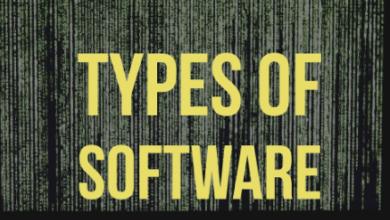Types of Computer Memory
Table of Contents
This topic is all about memory, different types of computer memory with their categories and functions. The difference between RAM & ROM is also elaborated completely. For more information, let’s read it.
Memory
Data and instructions are stored in memory to be executed. This memory is a temporary storage unit for data, instructions, and information. It is also called primary storage. It consists of one or more chips on the motherboard. The memory stores the following three items:
- Operating system and other system software to control the use of computer system
- Application programs to perform specific tasks
- Data to be processed by application programs
The instructions and data are stored in memory as bytes during execution. Each byte in the memory has a unique address that identifies its location.
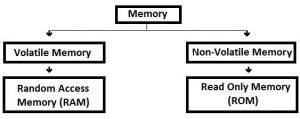
Types of Computer Memory
There are two types of computer memory:
Volatile Memory: volatile memory loses its contents when a computer is turned off.
Non-Volatile Memory: it does not lose its contents when a computer is turned off.
RAM
RAM stands for Random Access Memory. it is also known as main memory or direct access memory. Random access describes that each byte in the entire memory is directly accessible. Before execution, every program must be loaded into RAM.
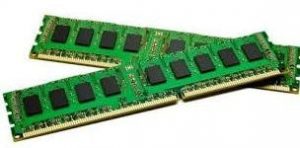
RAM is a temporary memory. When the power is turned off, the information in this memory is lost. Thus it is called volatile memory.
Furthermore, the role of RAM is also important in the processing speed of a computer. A larger RAM size allows a larger amount of space for processing. So the processing speed is increased.
CPU can read data from RAM and write data to RAM. Because of this reason RAM is also called read or write memory. Data and instruction are stored in RAM while it is being executed.
Types of RAM
There are two types of RAM
Static RAM
SRAM stands for static random access memory. Digital gates are used to construct memory cells. Each cell can store its value without any need to refresh the data as long as the power is available.
SRAM is more expensive. It does not need to be power refreshed. CPU does not wait to access data. That is why it is faster. It utilizes more power than DRAM. It is generally used to construct a very fast memory called cache memory.
Dynamic RAM
DRAM stands for dynamic random access memory it is a type of memory that is used in most computers. It is the least expensive kind of RAM.
DRAM needs an electric current to sustain its electrical state. As time passes, the electrical charge of DRAM decreases which may result in data loss. To maintain data, DRAM needs to recharge or refresh again and again. When DRAM is being refreshed, the processor cannot access its data. Because of this reason, it is slow.
Differences Between SRAM and DRAM
The difference between SRAM and DRAM is as follows:
|
SRAM |
DRAM |
| SRAM is faster than DRAM | DRAM is slower than SRAM |
| SRAM is more costly than DRAM | DRAM is less costly than SRAM |
| No need to be power refreshed | Needs to be refreshed again and again after each read operation |
| It uses less power | It uses more power |
Types of Computer Memory Module
RAM is mounted on a small circuit board called a memory module. The memory module is mounted on a motherboard. Three types of memory modules are as follows:
SIMM: SIMM stand for Single Inline Memory Module. In this module, to form a single set of contacts the pins on opposite sides of the circuit board connected together
DIMM: DIMM stands for Dual Inline Memory Module. In this module, the pins on opposite sides of the circuit board do not connect and form two sets of contacts.
RIMM: RIMM stands for Rambus Inline Memory Module. It houses SDRAM chips.
ROM
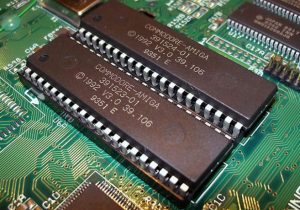
The information in ROM is stored by the manufacturer. The instructions in the ROM are automatically loaded into the memory of the computer when it is turned on.
Types of ROM
Different types of ROM are as follows:
PROM
PROM stands for Programmable Read-Only Memory. This form of ROM is initially blank. The user or manufacturer can write data on it using special devices. The user can also write data and instructions on it only once.
If there is an error in writing the instructions, the error cannot be removed from PROM. The chip becomes unusable. It is used to store the programs or data developed by the user.
EPROM
EPROM stands for Erasable Programmable Read-Only Memory. The user can erase instructions or data stored in the EPROM chip by exposing the chip to ultraviolet light and writing new programs.
EEPROM: EEPROM stands for Electronically Erasable Programmable Read-Only Memory. The user can use electric pulses to erase and write commands. If there is an error in writing the instructions, the user can also erase the contents electrically.
Difference Between RAM & ROM
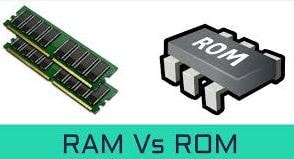
The difference between RAM and ROM is as follows:
|
RAM |
ROM |
| RAM is a temporary memory | ROM is a permanent memory |
| It enables data to be both read and written to memory and data can be changed or deleted | The instructions written in ROM can only be read but cannot be changed or deleted |
| Instructions loaded in RAM change continuously because different programs are executed and new data is processed | It is not possible to write new information or new instructions into the ROM, so it is an unchangeable memory |
| When the power is turned off, all the programs and data are erased from RAM. So, it is a volatile memory | When the power is turned off, the instructions stored in ROM are not lost, therefore ROM is a non-volatile memory |
| The user will write instructions into the RAM at the time of execution | The user will write instructions into ROM at manufacturing time. |
Difference Between PROM and EPROM
The difference between PROM and EPROM is as follows:
| PROM |
EPROM |
| PROM is a programmable memory | EPROM is an Erasable programmable memory |
| The user can write instructions on PROM only once | The user can write instructions on EPROM many times |
| The instructions written by the user cannot be erased from PROM | The instructions written by the user can be erased from EPROM |
| While writing on PROM if an error occurs, it becomes unusable | While writing on EPROM if an error occurs, it can still be used again |
| Instructions are written only once, so it provides less usability | Instructions are written many times, so it provides more usability |
Try This:
- PikaShow APK Download V72
- Semawur APK V1.0
- BOMBitUP APK
- VideoShow APK [Premium Unlocked]
- Advantages of Algorithms
- 6 Steps In Booting Process
- GUI Vs CLI
- Types of Network Protocols


